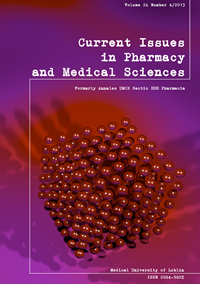Principles for magnetic resonance examination in case of the cervical cancer
DOI:
https://doi.org/10.12923/j.2084-980X/26.4/a.14Keywords:
cervical cancer, diagnostics, progression, magnetic resonance, contraindications, lymph nodesAbstract
Magnetic resonance (MR) is the optimal, non-invasive method that allows for precise determination of the degree of cervical cancer progression. It also facilitates the evaluation of tumor volume and structure as well as infiltration of adjacent tissue/organs and enlargement of lymph nodes. Proper qualification and appropriate preparation of patients for the examination is a necessary condition for securing patient’s safety and obtaining good quality images. Presently, MR of the lesser pelvis should be performed for most women before any treatment will be initiated. However, an absolute contraindication for the examination is the presence of a pacemaker, cochlear implant, metallic foreign object in the eye ball, metallic surgical clips and lack of verbal contact with the patient, especially deafness. Relative contraindications are pregnancy, especially in the first trimester, claustrophobia, metal foreign objects in soft tissues, metal orthopedic implants, prosthetic heart valve, dental implants, monitoring devices, dosing devices (e.g. insulin pump), permanent make-up or tattoo.
References
1. Będkowska G.E., Ławicki S., Szmitkowski M: Molekularne markery karcynogenezy w diagnostyce raka szyjki macicy. Postepy Hig. Med. Dosw., 63, 99-105, 2009.
2. Cabrera Y. et al.: Cáncer de cérvix. Análisis de 72 casos. Oncología (Barc.), 28, 26-32, 2005.
3. Camisão C.C. et al.: Magnetic resonance imaging in the staging of cervical cancer. Radiol. Braz., 40, 207-215, 2007.
4. Chen M.M. et al.: Guidelines for computed tomography and magnetic resonance imaging use during pregnancy and lactation. Obstet Gynecol. 112(2 Pt 1), 333-340, 2008.
5. Dewey M., Schink T., Dewey C.F.: Frequency of referral of patients with safety-related contraindications to magnetic resonance imaging. Eur. J. Radiol., 63, 124-127, 2007.
6. Didkowska J., Wojciechowska U., Zatoński W. (2011). Nowotwory złośliwe w Polsce w 2009 roku. Centrum Onkologii Instytut, Warszawa.
7. Freeman S.J. et al.: The revised FIGO staging system for uterine malignancies: implications for MR imaging. Radiographics, 32, 1805-1827, 2012.
8. Greer B.E. et al.: National Comprehensive Cancer Network. Cervical cancer. J Natl Compr Canc Netw. 6, 14-36. 2008.
9. Jońska-Grymek J. et al.: Rokownicze znaczenie utkania histopatologicznego u chorych na raka szyjki macicy. Ginekol. Pol., 81, 668-673, 2010.
10. Jung D.C. et al.: The validity of tumour diameter assessed by magnetic resonance imaging and gross specimen with regard to tumor volume in cervical cancer patients. Eur. J. Cancer, 44, 1524-1528. 2008.
11. Kamimori T. et al.: Parametrial involvement in FIGO stage IB1 cervical carcinoma diagnostic impact of tumor diameter in preoperative magnetic resonance imaging. Int. J. Gynecol. Cancer, 21, 349-354, 2011.
12. Koh W.J. et al.: Cervical cancer. J. Natl. Compr. Canc. Netw., 11, 320-343, 2013.
13. Levine G.N. et al.: Safety of magnetic resonance imaging in patients with cardiovascular devices. Circulation, 116, 2878-2891, 2007.
14. Mocarska A. et al.: Usefulness of magnetic resonance in evaluation of cervical cancer progression. Ginekol. Pol., 83, 122-127, 2012.
15. Parikh S., Brennan P., Boffetta P.: Meta-analysis of social inequality and the risk of cervical cancer. In. J. Cancer, 105, 687-691, 2002.
16. Perżyło K. et al. Therapeutic and prognostic vaule of lymphademectomy in ginecological oncology. Ginekol. Pol., 84, 630-636, 2013.
17. Schmidt G.P., Reiser M.F., Baur-Melnyk A.: Whole-body MRI for the staging and follow-up of patients with metastasis. Eur. J. Radiol., 70, 393-400, 2009.
18. Shellock F.G., Crues J.V.: Magnetic resonance procedures: health effects and safety. Radiology, 232, 635-652, 2004.
19. Shweel M. et al.: Uterine cervical malignancy: diagnostic accuracy of MRI with histopathologic correlation. J. Clin. Imaging Sci., 2, 42-47, 2012.
20. Sobin L., Gospodarowicz M., Wittekind Ch. (2009). TNM classification of malignant tumors. Seventh Edition (International Union Aganist Cancer). Wiley-Blackwell; p. 207-211.
21. Spensley S. et al.: Clinical outcome for chemoradiotherapy in carcinoma of the cervix. Clin. Oncol., 21, 49-55, 2009.
22. Stikova E.: Magnetic resonance imagining safety: principles and guidelines. Prilozi, 33, 441-472, 2012.
23. Wagner A.E. et al.: Impact of tumor size on survival in cancer of the cervix and validation of stage IIA1 and IIA2 subdivisions. Gynecol. Oncol., 129, 517-521, 2013.
Downloads
Published
Issue
Section
License
Copyright (c) 2013 Authors

This work is licensed under a Creative Commons Attribution-NonCommercial-NoDerivatives 3.0 Unported License.


